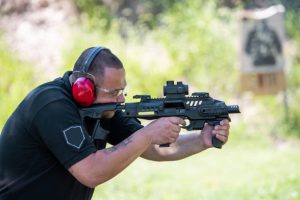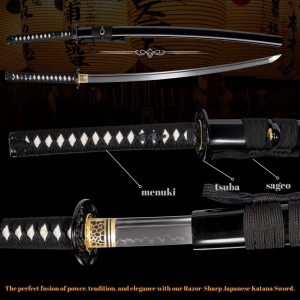The katana is a weapon that represents a historical narrative combining fire and steel with centuries of traditional Japanese practices. Its distinctive curved blade and legendary sharpness have captivated enthusiasts worldwide, leading many to wonder if any other blade can match its cutting prowess, especially within the UK.
This question often sparks passionate debate among collectors, martial arts practitioners, and historians. While the katana is undeniably a masterpiece of metallurgy and design, declaring any sword the absolute “sharpest” requires a careful look at different factors—from cutting ability and durability to its intended purpose and legal standing. This post will explore what makes the katana so extraordinary, compare it with other renowned blades available in the UK, and examine the practical considerations for sword enthusiasts in Great Britain.
A Marvel of Japanese Craftsmanship
The katana’s legacy is deeply rooted in Japan’s warrior class, the samurai. These swords were more than mere weapons; they transformed into symbols of honor, status, and spiritual identity. The mystique surrounding the katana begins with its unique construction, a process perfected over centuries.
Traditional katana construction represents a pinnacle of metallurgical artistry. Master swordsmiths employed a technique called differential hardening to create the distinctive hamon (temper line) that runs along the blade’s edge. This process involved coating the blade with a special mixture of clay before heat treatment. This allowed the edge to cool very rapidly, becoming incredibly hard, while the spine cooled more slowly, remaining flexible and able to absorb shock. The result is a razor-sharp cutting edge supported by a resilient, less brittle spine—a perfect combination for a combat weapon.
A Handmade Katana requires several weeks to several months to finish. The process begins with selecting high-carbon steel, which is then folded multiple times to purify the material and create a uniform grain structure. This intricate forging is followed by shaping, heat treatment, and a long, meticulous polishing process that brings out the blade’s beauty and reveals its sharpness. The blade is then fitted with a full tang construction, meaning the steel extends completely through the handle (tsuka) for maximum durability. Wrapped in ray skin (same) and bound with silk or cotton cord (ito), the katana becomes a weapon that is both devastatingly functional and aesthetically stunning.
Sharpness Defined: Katana vs. Other Blades
When we talk about “sharpness,” it’s not a single, simple metric. Sharpness can refer to the fineness of the blade’s edge, its ability to hold that edge, and its overall cutting performance. The katana was designed primarily for cutting unarmored or lightly armored opponents, and its design reflects this specialization.
- The Katana’s Edge:The differential hardening process allows the katana’s edge (hagane) to be honed to an extreme degree of sharpness. Its gentle curve (sori) enhances this cutting ability by allowing for efficient drawing cuts, a technique central to Japanese swordsmanship like iaido. This design concentrates force along a small section of the blade as it moves, creating a slicing action that is incredibly effective.
- European Longswords:In contrast, the medieval longsword, one of Europe’s most iconic blades, was a jack-of-all-trades. Its straight, double-edged design was optimized for a balance of cutting and thrusting. While a well-made longsword is certainly sharp, it was engineered to be versatile against various types of armor, from mail to gaps in plate. Its edge geometry is typically more robust and less acutely angled than a katana’s to withstand the rigors of clashing against other swords and armor without chipping.
- Rapiers:Later European developments produced the rapier, a weapon almost entirely focused on thrusting. With its long, slender blade, a rapier’s primary function was to deliver a lethal point to an unarmored opponent in a duel. While it might have a secondary cutting edge, its design prioritizes piercing over slicing, making a direct sharpness comparison with a katana less relevant.
Scientific tests and historical accounts show that a high-quality katana can perform incredible cutting feats, slicing through bamboo mats (tatami omote) with almost no resistance. However, this doesn’t mean other swords aren’t sharp. A properly sharpened longsword can cleave through targets with formidable power. The key difference lies in their design philosophy: the katana is a cutting specialist, while many European swords were generalists designed for a different combat environment.
Swords in the UK: Legal and Practical Considerations
For enthusiasts in the UK, the question of sharpness is tied to what is legally available. Understanding UK sword laws is crucial for any collector or martial arts practitioner. The Offensive Weapons Act 2019 introduced significant restrictions.
- Ownership and Sales:It is legal to own swords in the UK, but there are strict rules about their sale. Curved swords with a blade length of 50cm or more, like many katanas, cannot be sold, imported, or manufactured unless they are handmade using traditional methods. This exemption allows for the legal purchase of genuine, high-quality Japanese swords but bans cheap, mass-produced replicas. Straight-bladed swords, like most European longswords, are generally not subject to this specific curvature restriction, making them more widely available.
- Why You Can Own One:You must be over 18 to purchase any sword. The law allows for ownership for legitimate reasons, such as collecting, historical reenactment, and martial arts practice. Being part of a registered club or organization can help prove legitimate interest.
- Transporting a Sword:Carrying a sword in public without a reasonable excuse is illegal. A valid reason would be transporting it to or from a martial arts class or a historical event. The sword must be carried securely and out of sight.
Because of these laws, the UK market for katanas is geared toward either high-end, traditionally made pieces or specific models for martial arts practitioners. In contrast, a wider variety of European-style swords may be more accessible.
The Final Cut
So, is there a sharper blade than a katana in the UK? The answer isn’t a simple yes or no. A traditionally forged and polished katana possesses one of the sharpest edges ever created for a sword, optimized for pure cutting performance. In a test of pure slicing ability, a high-quality katana would likely outperform most other sword types.
However, “sharpness” is only one aspect of a sword’s effectiveness. European swords like the longsword were also incredibly sharp but were designed with a different purpose in mind—one that required a balance of cutting, thrusting, and durability against armor.
For the UK enthusiast, the katana remains a symbol of ultimate craftsmanship and cutting power. While other exceptionally sharp swords are available, the katana holds a unique place due to its specialized design and the artistry behind its creation. Its legendary status is well-earned, not just for its sharpness, but for its perfect fusion of form, function, and cultural heritage. The “best” or “sharpest” sword ultimately depends on the criteria you value most: pure cutting efficiency, versatility, or historical context.



